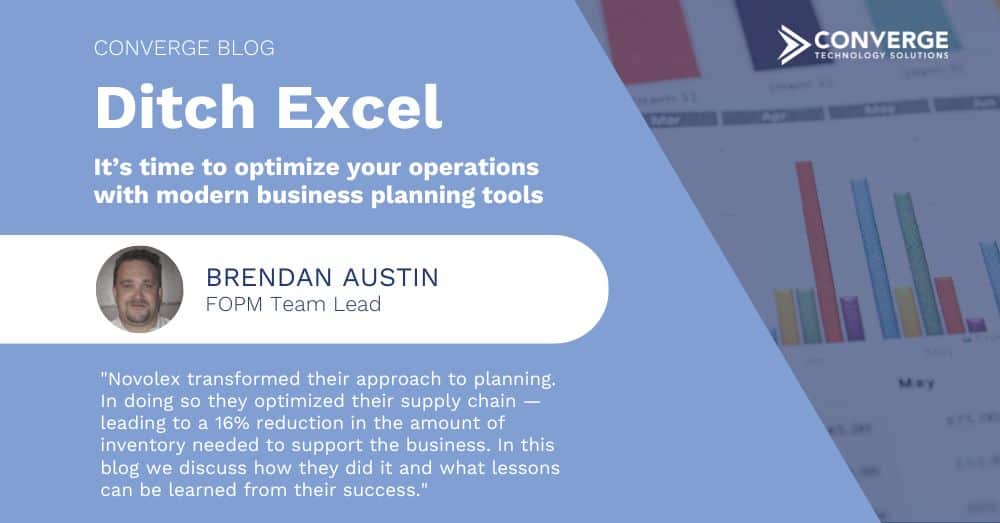Organizational planning is critical to keeping business operations running smoothly. It’s a complex, interdependent effort that touches nearly every part of the business—from sales, to supply chains, to finance, to HR and more. You may be surprised to learn that in many organizations a lot of planning and analysis is still being done in Microsoft Excel. Why is that? It’s because almost everyone is familiar with Excel.
However, using Excel for operations means analysts manage and update hundreds of individual spreadsheets each month. Often, spreadsheets are emailed back and forth between team members and departments, leading to multiple versions of the truth floating around in duplicate spreadsheets. Analysts spend hours upon hours each month doing data entry and version control when they could be spending that time doing actual business analysis. Using Excel is labor intensive, costly and not secure. The collaboration that Excel requires slows down planning cycles and diminishes the trust in data needed for decision-making.
Fortunately, there are better tools available, some of which can even leverage Excel as the front end. Connecting to a modern back-end system that centralizes data to create a single version of the truth is easy with built in automation. Less time and effort are needed for data entry and analysis, which enables faster planning cycles. Cross department collaboration is infinitely easier. And rigorous security permissions enables trust in the data.
These tools facilitate faster, more accurate planning with less resources. An example of this is, food packaging leader, Novolex who transformed their approach to planning. In doing so they optimized their supply chain—leading to a 16% reduction in the amount of inventory needed to support the business. Below we discuss how they did it and what lessons can be learned from their success.
Novolex plans better in turbulent times
The challenge: Supply chain variability
Grocery stores and restaurants rely on Novolex’s packaging products to run their businesses. During a turbulent couple of years, the inventory needs of these businesses changed frequently, which put a strain on Novolex’s supply chain.
Novolex had trouble adapting production to meet demand quickly enough because production schedules and sales planning/forecasts were not aligned. Production planning for the company’s various plant locations and ERP systems happened either quarterly or biannually. On the other hand, sales ran forecasts and budgets annually.
“We did not have up-to-date information to make sure that sites were producing enough volume without producing inventory unnecessarily.” According to Violeta Nedelcu, Supply Chain Director at Novolex. This impacted everything from raw materials and production floor planning to logistics and machinery capacity.
The solution: Choosing the right tech and partner
Novolex started off by creating a single strategy for their organization’s forecasting process. Instead of having different planning cycles, the company created a unified forecast. Each month, they would create a complete production plan, which forecasted inventory and planning activities for Novolex and their suppliers.
Next, Novolex needed a modern technology solution to support faster planning cycles. The company wanted a solution that could connect their different systems on a single platform. So they chose software to support weekly and monthly reporting for sales, operations, engineering, and marketing operations.
To bring their vision to life, Novolex reached out to Converge. On the partnership, Nedelcu said “By having someone from IBM available, through Converge, to check in and address the questions that came along with development—we definitely haven’t had an issue or a roadblock where we didn’t have a solution.”
Converge brought the business and technology expertise to enable a seamless implementation. This included standardizing metrics, eliminating process bottlenecks, and optimizing system design for deployment and adoption.
The results: Agility delivered
With a new planning strategy and solution in place, Novolex is seeing improvements in business performance:-
- Less inventory needed: During a turbulent year in the food service industry, better forecasting processes helped Novolex support their business with less inventory. “One of our goals from the very beginning was to address the capacity,” Nedelcu adds. “This year, we’ve been able to improve our inventory position by about 16%.”
- Faster forecasting achieved: Novolex is executing supply chain forecasts 83% faster. Where it used to take six weeks, the company can now complete a forecast in less than a week.
Novolex’s partnership with Converge made implementation seamless and fostered adoption of the new system. According to Nedelcu, “The ease of implementation, in phases, helped get engagement from the users—it wasn’t a scary thing. Converge has definitely made the road easier. We’ve received all the support that we needed.”
Novolex now has the ability to adapt to dynamic changes in demand with timely, accurate supply chain information. And they are using prescriptive analytics to make smart decisions about their inventory needs in an ever-changing food service environment.
Tips for transformation success
Transforming your supply chain may seem daunting. Here are three key tips to ensure your success.-
- Focus on the vision, not recreating the status quo: When it comes to organizational planning, focus on what is needed for your business to grow, instead of what you already have. Think about your goals—whether it’s faster planning cycles, better insights or improved collaboration—and what would have the most impact for your business. It’s easy to get stuck in old ways of doing things, and it’s a waste of time, energy and money to simply recreate the status quo in a new system. Think about the bigger picture and what capabilities would unlock the most value, even if the upfront lift is a bit steeper in terms of time and effort.
- Identify great use cases for automation: In any given business, there are lots of opportunities to use automation to create value. Any process where you are asking users to input something—review, update, or share—is a good use case for automation or analytics. For example, with the right tool, changes to a sales plan can be automatically updated a finance plan for an upcoming quarter. Demand plans can automatically update revenue plans. Call-center staffing plans can automatically update divisional expense plans, and so forth across the enterprise.
- Training is essential, every step of the way: Look for a partner that will provide in-depth training upfront for both your business and finance teams. Since they are the people actually using the planning tools, it’s important that they are involved in the process. Planning and implementation should be a collaborative effort, where there is transparency around what’s being created. By the time deployment happens, your team should be experts in the tools so your organization can get the most value from them.
Planning (and taking) your best next step
Better planning capabilities can have a significant impact on the bottom line. Converge brings deep finance and business experience to every organizational planning implementation. We will help you achieve your vision, in a way that best fits your unique business needs rather than fitting your business operations around technology tools. Want to learn more? Contact us today!
Converge Technology Solutions Corp. is a services-led, software-enabled, IT & Cloud Solutions provider focused on delivering industry-leading solutions. Converge’s global approach delivers advanced analytics, application modernization, cloud platforms, cybersecurity, digital infrastructure, and digital workplace offerings to clients across various industries. Converge supports these solutions with advisory, implementation, and managed services expertise across all major IT vendors in the marketplace. This multi-faceted approach enables Converge to address the unique business and technology requirements for all clients in the public and private sectors.





